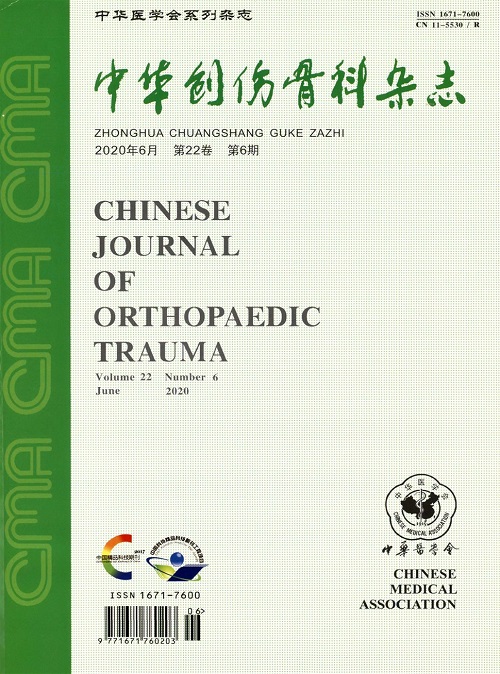Instrumentation with 3D printed patient-specific guides versus conventional techniques in supramalleolar osteotomy for varus ankle osteoarthritis
Q4 Medicine
引用次数: 0
Abstract
Objective To compare instrumentation with 3D-printed patient-specific guides versus conventional techniques in supramalleolar osteotomy for varus ankle osteoarthritis. Methods A retrospective analysis was done of the 21 patients with varus ankle osteoarthritis who had been treated at Department of Orthopaedics, Shanghai JiaoTong University Affiliated Sixth People's Hospital from January 2017 to December 2018. They were divided into 2 groups by their treatment methods. In the 9 patients treated by instrumentation with 3D-printed patient-specific guides, there were 6 males and 3 females with an age of 54.6±8.6 years, 4 left and 5 right sides involved, and one case of Takakura stage 1, 3 cases of Takakura stage 2 and 5 cases of Takakura stage 3a. In the 12 patients treated by conventional techniques, there were 7 males and 5 females with an age of 53.0±6.5 years, 7 left and 5 right sides involved, and one case of Takakura stage 1, 5 cases of Takakura stage 2 and 6 cases of Takakura stage 3a. The 3D printed guide group and the conventional group were compared in terms of operation time, intraoperative blood loss and frequency of intraoperative fluoroscopy, tibial anterior surface angle (TAS), talar tilt angle (TT), and tibial lateral surface angle (TLS). The differences in TAS, TT and TLS between pre- and post-operation in the 3D printed guide group were also evaluated. Results There were no significant differences in the preoperative general data between the 2 groups (P>0.05), indicating they were comparable. All the patients were available for follow-up for an average of 7.8 months (from 3 to 15 months). The 3D printed guide group incurred significantly shorter operation time (106.2±10.6 min), less intraoperative blood loss (207.2±16.0 mL) and lower fluoroscopy frequency (2±0) than the conventional osteotomy group (all P 0.05). Conclusions Compared with conventional techniques, instrumentation with 3D-printed patient-specific guides can shorten operation time and reduce intraoperative blood loss and fluoroscopy frequency. The 3D printed patient-specific guides in osteotomy can facilitate accurate correction of varus deformity, leading to similar efficacy compared with conventional osteotomy. Key words: Ankle joint; Ostearthritis; Osteotomy; 3D printing; Patient-specific guide; Supramalleolar osteotomy3D打印患者专用导向器与传统技术在踝内翻骨关节炎踝上截骨术中的对比
目的比较3d打印患者专用导板与常规技术在踝上截骨治疗踝关节内翻性骨关节炎中的应用。方法回顾性分析2017年1月至2018年12月上海交通大学附属第六人民医院骨科收治的踝关节内翻性骨关节炎患者21例。按治疗方法分为两组。9例采用3d打印患者专用导尿管内固定治疗的患者中,男性6例,女性3例,年龄54.6±8.6岁,左右两侧受病灶4例,高仓期1例,高仓期2例,高仓期3a 5例。12例采用常规方法治疗的患者中,男性7例,女性5例,年龄53.0±6.5岁,左侧受累7例,右侧受累5例,高仓期1例,高仓期2例,高仓期3a期6例。比较3D打印导具组与常规组手术时间、术中出血量、术中透视次数、胫骨前面角(TAS)、距骨倾斜角(TT)、胫骨外侧面角(TLS)。并比较3D打印导盲组术前、术后TAS、TT、TLS的差异。结果两组术前一般资料比较,差异无统计学意义(P < 0.05),具有可比性。所有患者平均随访7.8个月(3 ~ 15个月)。3D打印导骨组手术时间(106.2±10.6 min)明显短于常规截骨组,术中出血量(207.2±16.0 mL)明显少于常规截骨组,透视频率(2±0)明显低于常规截骨组(P均0.05)。结论与常规技术相比,使用3d打印的患者专用导尿管可以缩短手术时间,减少术中出血量和透视次数。3D打印的患者专用截骨指南可以准确矫正内翻畸形,与传统截骨术效果相近。关键词:踝关节;Ostearthritis;截骨术;3 d打印;针对病人的指导;Supramalleolar截骨术
本文章由计算机程序翻译,如有差异,请以英文原文为准。
求助全文
约1分钟内获得全文
求助全文

 求助内容:
求助内容: 应助结果提醒方式:
应助结果提醒方式:


